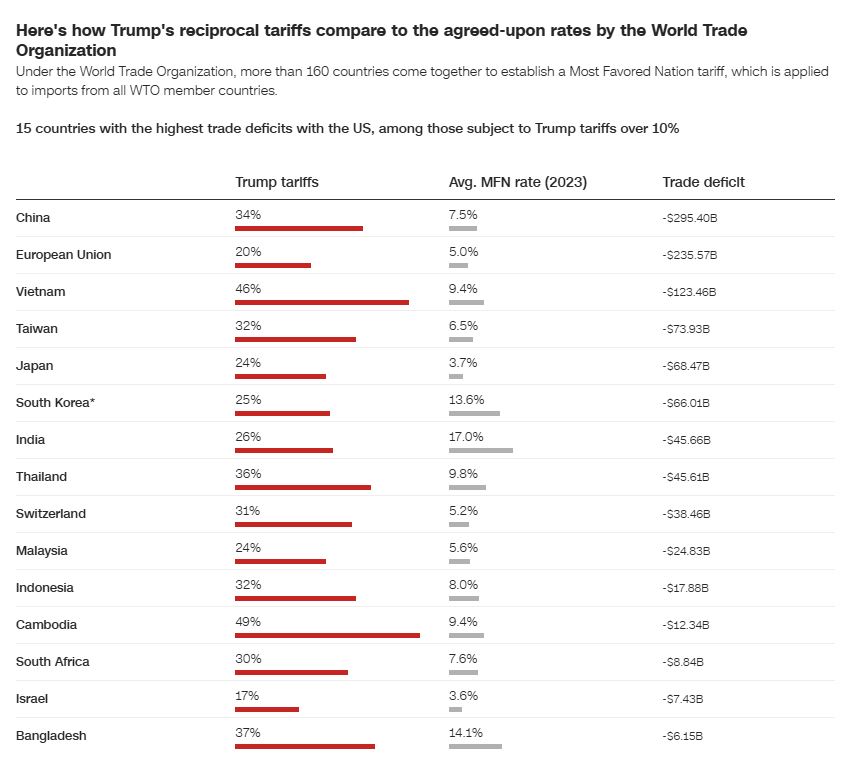The sweeping tariffs announced by President Donald Trump on Wednesday, targeting numerous US trading partners, were presented as "reciprocal"—an attempt to match the tariffs other countries impose on American goods.
However, the methodology behind these tariffs strays far from that simple logic.
A Flawed Formula
Rather than basing the tariffs on actual foreign tariff rates, the Trump administration employed a crude calculation. It divided a country's trade deficit with the US by its exports to the US, then multiplied that result by 1/2. This overly simplistic formula doesn't reflect the real-world complexities of international trade, which include factors such as investment policies, currency manipulation, and regulatory barriers.
Mike O'Rourke, Chief Market Strategist at Jones Trading, noted in a statement to investors that "there does not appear to have been any tariffs used in the calculation of the rate." Instead, the administration specifically targeted countries with large trade surpluses relative to their exports to the US
Misrepresenting Tariff Rates
In reality, the more accurate measure of tariffs is the "Most-Favored-Nation" (MFN) applied tariff rate—a cap agreed upon by over 160 World Trade Organization (WTO) members. These rates vary by country and by sector and are often reduced or eliminated in the context of trade agreements.
For example, the European Union's MFN rate is around 5%. However, the Trump administration claimed it was closer to 20% due to alleged non-tariff barriers, such as inconsistent customs enforcement and opaque regulatory processes. Vietnam's MFN rate stands at 9.4%, but the administration inflated it to 46% based on similar non-tariff grievances, including quotas and anti-dumping measures.

Vietnam's top trade official condemned the new tariffs as "unfair," citing the actual MFN rates. Other countries like India and China also have non-tariff barriers—such as agricultural import restrictions and government subsidies—but experts argue that Trump's approach isn't the right solution.
A Misguided Response to Non-Tariff Barriers
Sung Won Sohn, an economics professor at Loyola Marymount University, and Joe Brusuelas, Chief Economist at RSM, both criticized the administration's tariff strategy. Brusuelas emphasized that the formula used to justify the tariffs failed to account for non-tariff barriers and appeared to be a punitive response based on trade balances alone.
''The bilateral trade balance the US runs with other countries," he said, "This is simply a function of American saving and spending patterns."
Trade Deficits Aren't Inherently Bad
Despite being labeled a "national emergency" by the White House, trade deficits aren't necessarily harmful. The US runs significant deficits with both the EU ($230 billion) and China ($300 billion), but economists caution against overreacting.
John Dove, an economics professor at Troy University, explained the concept with a simple analogy: "When I go to the store and buy groceries, I run a trade deficit with my grocery store. Does that mean I'm worse off? Of course not."
Trade deficits reflect consumer demand and purchasing power—not economic failure.
The Risk of Retaliation
While the Trump administration sees tariffs as a revenue source to reduce the national debt and fund tax cuts, experts warn that this could backfire. Retaliation from trading partners is a real threat.
"These large across-the-board tariffs incentivize our trading partners to retaliate," Dove warned. "If that happens, the US could quickly find itself isolated—25% of the global economy facing off against the other 75%. And it's not hard to guess who comes out ahead in that scenario."





